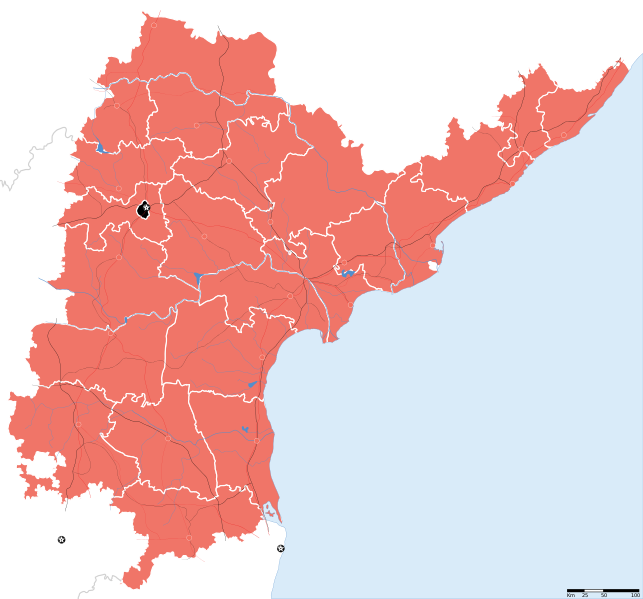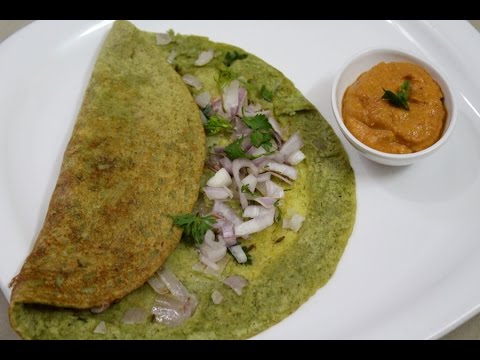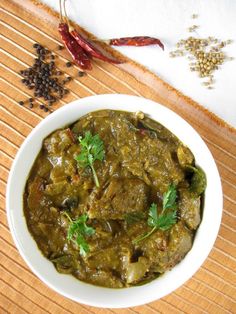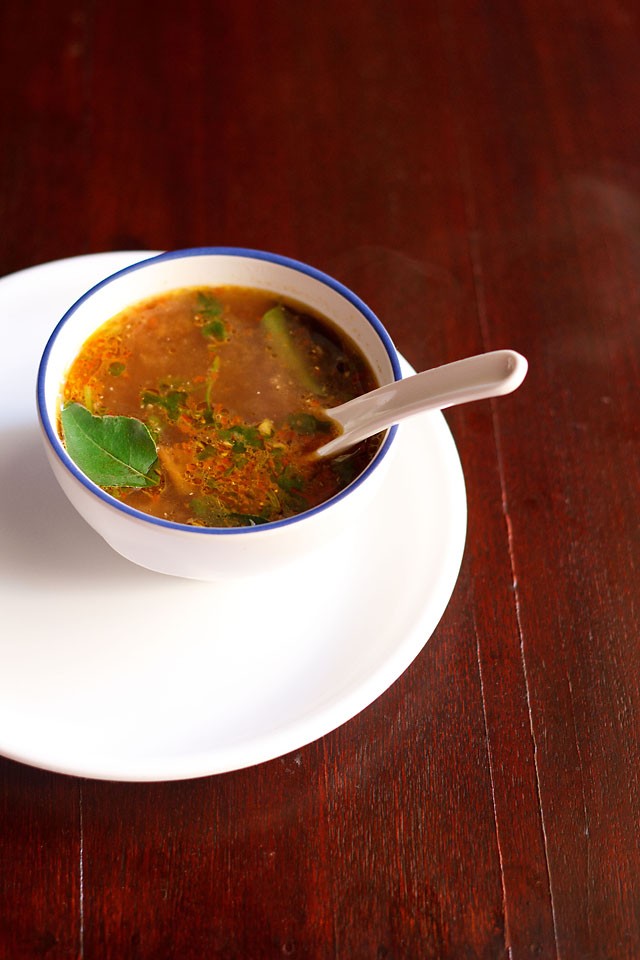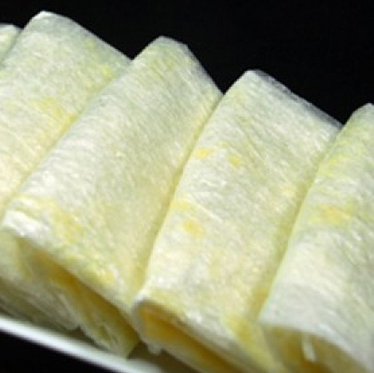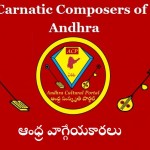Hullo Everybody, after long break I am back! You must be wondering what I am upto 😉 . Well, here it is: Velugu Thalli’s Culinary Tour of Andhra Part 1!! 😎 .
For our Andhra Aaahaara Yaathra, I originally thought to do region by region or even district by district, but our people are so divided, they may even ask for “caste by caste” 🙄 . So because I want to avoid this, and because I want to show unity of all Telugus and their culture, I will simply do it in numbered menus, with something for different regions and dietary restriction in each one.
Long time readers may remember my first post! 😀 and my follow up post: Vivaha Bhojanambu (Nonveg Edition). There will be very little repetition between the Vivaha Bhojanambu blogs and the Culinary Tour of Andhra, but some overlap may happen.
What I will do here is describe a traditional Telugu meal, and then give a list of Appetizers, Main Courses, Sides, Desserts, and Beverages all together, and finally, show what is special about each region. This way, rather than have regional menus, we can have mix and match Andhra Vindu for a taste of true Telugu food. Kadupaara Bhujinchandi!
Introduction
The essential ingredients of Andhra Cuisine are tamarind, the chilli pepper, and of course that signature Telugu contribution to Indian cuisine: the Roselle leaf, aka GONGURA!!.
Tamarind helps to digest the rich, tasty, and peerlessly spicy cuisine of Andhra. Along with plentiful amounts of Yoghurt (perugu), Tamarind (chinthakaaya or chinthapandu) is used to cool the stomach. Its health effects reputedly include the blocking and absorption of flourine [2].
“It is said that an Andhraite gets his hot temper from his food!” [1]
“Koraivikaram, the flaming stick” from Guntur is the hottest chilli from the hottest district from the hottest state cuisine [2]. Guntur is in fact famous for its chillies, so it is no surprise that we turn here for this ingredient.
#ContestAlert
Hundreds of tons of chillies are bought from here for trade every day. Name the town which is home to Asia’s Largest Chilli Market. #VisitAndhra #AmazingAndhra #AndhraPradesh pic.twitter.com/pq5gBaDDvn— AP Tourism (@Tourism_AP) July 17, 2018
Gongura, also known as Ambada, is the most unique aspect of Andhra cooking. The signature sour sorrel adds a tart taste, and gives our aahaaram its reputation for ruchi. Flavourful food is certainly a hallmark of our region.
Other common ingredients naturally include turmeric (pasupu), asafoetida (hing), and clove (lavanga). While pappad (appadaalu) are common, it is vadiaalu that add the crunch to the variety of soft curries and stews.
In the first Culinary Tour of Undivided Andhra, I will give general introduction and description of our cuisine. Later on, will go into specialties, etc.
A Traditional Andhra Meal
Some of you may be wondering why there is no biryani here, despite some famous comments on what “Andhra Biryani” supposedly tastes like 😉 . Well that is because Biryani isn’t a native Andhra dish!! But then, one should also know Pothana Mahakavi is from Telangana… 😎 .
Pulao is our traditional gourmet rice dish and dates back to the Sanskrit word Pulaka. The Andhra (or Southern variety in general) may be characterised by cooking in Coconut milk. Nuts, and other spices can be added to taste.
While it is true that foreigners and recent foreign arrivals like to pretend everything good in India came from outside (just like they pretend they are closer to some Telugus than Telugus are closer to each other!), even if most of our good stuff is native, we should acknowledge what came from outside, but give patronage to our own native items.
So what then is a traditional Andhra meal?
Some may argue that there is no such thing as 1 traditional Andhra meal as there are various sub-cultures for different communities. While there is obviously truth to that, coming from orthodox household, there are enough commonalities to say that there enough constants to give a basic traditional meal.
Others may assert, that that there are different types for different stripes. But traditionally speaking, from the Ancient period down to Modern day, there are some consistent themes. One is the sanctity of the cow, as well as the use of milk products originating from it:
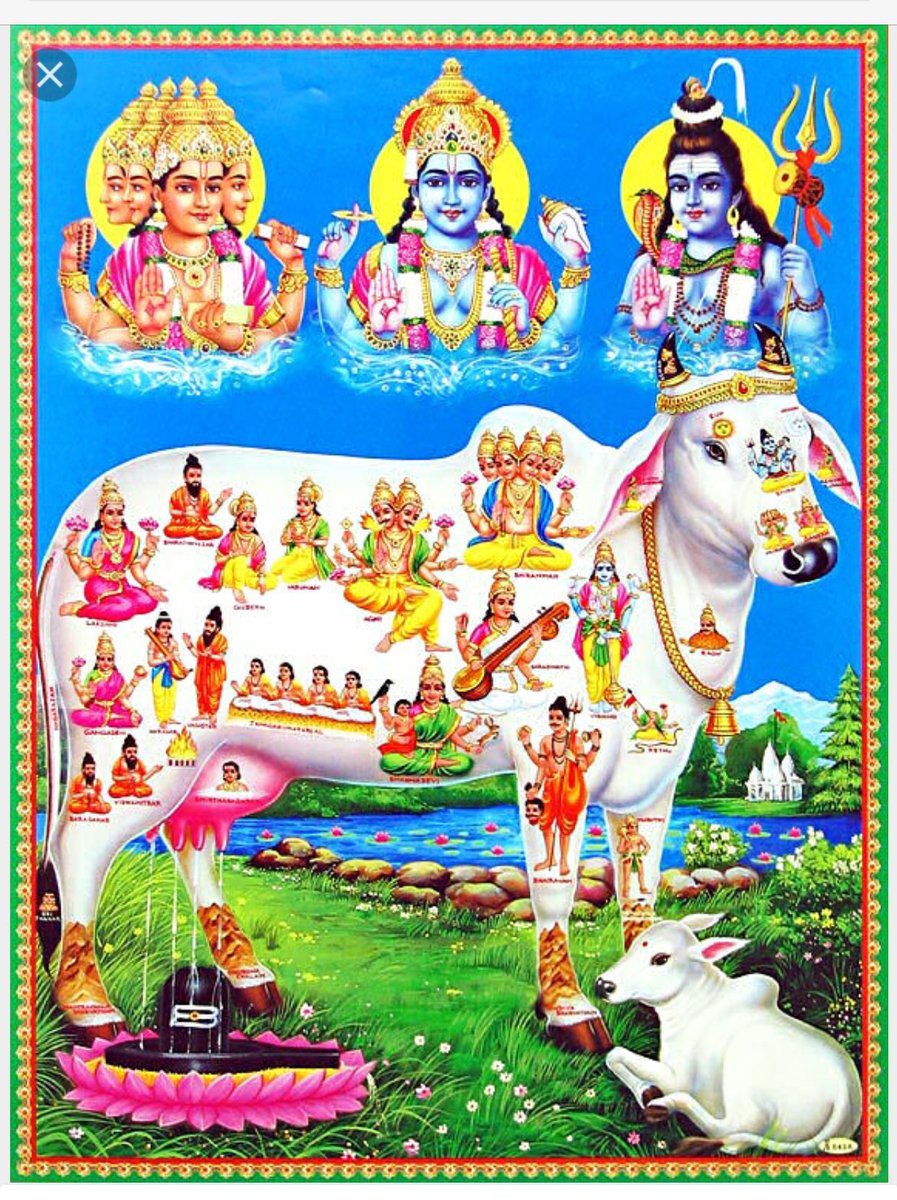
These milk products include milk itself (dugdham/paalu), curd (dadhi/perugu), buttermilk (thakram/majjiga), butter (naveeneetham/venna), and ghee (ghrtam/neyyi). Therefore, traditional Telugu foods will in part be based on some or all of these products.
“A traditional Andhra meal is well choreographed. People sit on floor mats or raised wooden seats”. Banana leaves are used in orthodox and common households. More aristocratic families will use silver plates (especially for special occasions). [1] These days it is common to use steel plates. Rice is the main staple of Andhra (which is the Rice Bowl of India), and ghee is used for gravy-based and dry curries alike. The Sanskrit word for curry is vyanjam (koora in Telugu) and rice is of course annam.
“A meal begins with a chutney, powder pickle and goes on to a cereal and then a ‘curry’ and then a ‘pulusu’. Almost as if thought up by a dietician, the last course, yoghurt, is an ideal coolant after all the exciting flavors before it”. [1] This is, of course, all the more important for an Andhra meal, which has a heavy Telugu accent (spice!).
Thoor and Green gram are the most common basic Andhra Pulses. [1] Some signature vegetarian dishes include Banana stem koora (arati doota) and Banana flower koora (arati puvvu), which should whet the appetite of vegetarians.
In case you were wondering why people still eat with hand (even in this day and age), wait till you discover Drumstick curry (Mullakaada koora)! And even on those rare occasions when Andhra cuisine is not tasty, it is very healthy—not only Mullakaada, but just see Kaakarakaaya koora which according to traditional medicine, is good to help fight diabetes. And of course, who could forget, Bendakaaya koora (okra) for good memory! Chaaru (also called Rasam) is another such mainstay of Andhra meals and is said to be good for digestion (especially for you meat-eaters!).
For breakfast, while idlis and dosas are the common South Indian items, the signature Andhra tiffin is pesarattu (green gram crepe). Vadas, called Garelu in Acha Telugu, are also common with chutney. Pulihora (tamarind rice) is another such Andhra Essential, especially during Pandugas. Of course, no orthodox household is complete without Daddojanam (Yoghurt rice, ideally with mustard seeds) with the raka rakaalu of uragaayalu (pickles) we Andhraites have! My personal favourite is aavakaaya, but of course gongura and nimmakaya are favourites too.
Breakfast (Praatharaasamu)
Breakfast may have long come to have been known as “tiffin” in Bharatavarsha, but the correct name for Breakfast in Praatharaasamu. The South Indian breakfast is now world famous, but Andhra has its own specialties. This list will include both the well-known and the new. There are both veg and non-veg options. Though I am vegetarian, on request, I will include both for all readers.
Vegetarian
Pesarattu is the traditional All-Andhra breakfast option. It is a moong daal dosa (or as you can see from the colour, green gram) which goes very well with allam (ginger) pacchadi. Green Gram must be soaked for 3 hours prior.
Aavakaayannam. Some have asked what the most Andhra food is. Some have said pesarattu, others pulihora, or gongura maamsam (not for us vegetarians! 😉 ). But the correct answer is aavakaayannam. The beauty about it is that it can be served breakfast, lunch, or dinner.
Idli. The other South Indian specialty that also needs no introduction. Though many prefer sambar, it is best with kobbari kaaya (coconut) chutney or gongura pickle.
Dosa. Pan South Indian specialty that needs no introduction. Rava variety is a signature andhra breakfast. As for sub-region specific, raagi dosa is standard in Rayalaseema.
Dhibba Rotte. (Thick grainy crepes). Served with chutney or pickle. Dosa pindi is layered thick, and it is fried in a deep pan for a cup shape. Goes with ullikaara (onion with podi & red chilli).
Upma (especially Kuragaayalu Upma).

Also see Aahaaram’s own recipe contributed to ACP. This special item made by Telugus is called Majjiga Upma.
Uttapam. This needs no introduction or description. Goes well with Tomato Pacchidi

Non-vegetarian
Nonveg is typically not common in the mornings. Nevertheless, if one type of maamsahaari food is acceptable podhu podhuna, it is Egg (better known as Kodi guddu).
Kodi Guddu. This can come in many varieties, from poratu to western style scrambled.
Guddu Dosa. Eggs are a standard breakfast throughout the world. But in southern India, especially Andhra, it is common to have it with Dosa.
Poori Poratu. Poori with Andhra style scrambled eggs.
Lunch/Dinner (Bhojanam)
Starter/Appetiser
Chilli Pakoda. Mirapa kaaya Pakoda. Self Explanatory
Bonda. Fried dumplings with potato filling. Goes with chutney. Though arguably not uniquely Andhra, it has come to define street food in AP. Here is the Nellore variety featured.
Puli Bongaraalu. Masala Bonda, without filling. Goes with pickle.
Main Course
Andhra being the Rice Bowl of India naturally makes Rice the staple food and essential ingredient of Andhra Main Courses. Before imported biryani, we had rakka rakkaalu pulaavulu and pulihoras.
Pulihora. Tamarind Rice. The proverbial temple food, it is an all-South India item (known as puliogre in Karnataka), but has become an archetypal dish to every AP’ite. It can come in delish variations, such as Tomato Pulihora.
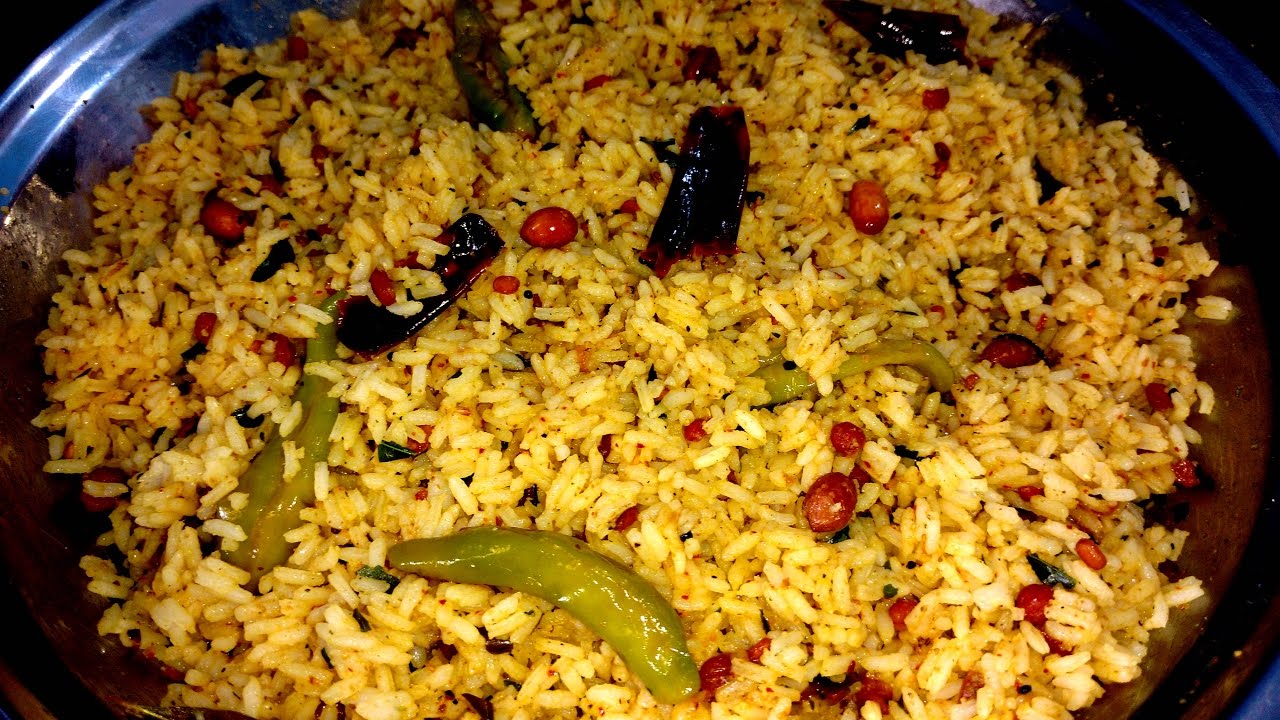 Daddojanam/Dadhyannam/Perugannam. Yogurt Rice. Dadhi means curd in sanskrit, so dadhyannam means curd rice, literally. Nevertheless, to us Telugus, it will always be perugannam.
Daddojanam/Dadhyannam/Perugannam. Yogurt Rice. Dadhi means curd in sanskrit, so dadhyannam means curd rice, literally. Nevertheless, to us Telugus, it will always be perugannam.
It is frequently served with mustard seeds and coriander, and ideally garnished with pickle (especially andhra aavakaaya)! It is the ideal follow up to Pulihora.
Chitrannam. Rice with cashewnuts and spices
Kobbarinnam. Coconut Rice
Kobbari Royyalu Pulao. Coconut and Prawn Pulao is very popular in coastal Andhra.
Kodi Pulao. Andhra Chicken Pulao
Mamidi kaaya Pulao. Mango Pulao
Garnishes/Chutneys/Pickles (Pacchadlu)
Simply known as Pacchadi, our pickles are their own artform in Andhra Pradesh. Since that alone can take up 1 post (or several!), will just give you snapshot here:
Coming in first is our own Aavakaaya. At the top of the list of most Andhra things to eat, is Aavakaaya (hot mango pickle). Leave it to Andhras to find already spicy dishes, and to make them even spicier by garnishing them with pickle! Aavakaaya (mustard mango pickle) is as Andhra as it gets. It is called that as it is mango mixed with aavaalu (powdered mustard) along with other spices.
Chillies and their preparation have been prepared to perfection in AP. After all there is red chilli pickle, green chilli pickle, and even dry chilli pickle.
Kaara Podi, spice and coriander powder, is used as an accompaniment to idli and other snacks, even appetizers.
Karivey Paaku Pacchadi. Curry leaves chutney.
Pudina Pacchadi. Mint Chutney. Typically has mustard, black gram, and of course, red chilli powder!
Pacchi Tomato Pacchadi. Raw tomato chutney includes chilli, tamarind, & mustard seeds.
Fried Green Chillies Chutney. Pacchi miripakaaya Kaaram. Along with green chillies, it has mustard seeds, fenugreek, and turmeric.
Chinthakaaya Pacchadi. Tamarind is another special ingredient in Andhra cuisine, so naturally there is a chutney for that.
Dosakaaya Pacchadi. Andhra Cucumber Pacchadi.
Of course, no list is complete without that Andhra essence, Gongura!! Hence Gongura Pacchadi is arguably the second most (or most!—depending on your perspective) Andhra pickle.
Snacks (Chiruthindlu/Laghu-bhojanamulu)
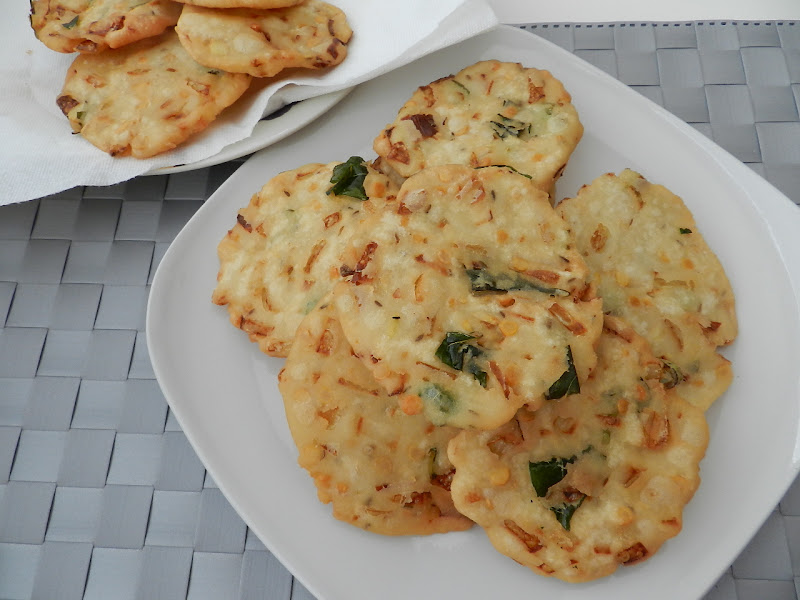
Snacks are a key part of any cuisine. Sometime they are there to keep us going until dinner, sometimes they are there just “nanchkodaaniki“, and sometimes some people make a meal of them!
Here are some classic Andhra snacks (though there might be some commonalities with other cuisines):
Chekkalu. Pictured above, these are a beloved Andhra snacks.
Chegodi. A ring shaped fried dough snack—they are absolutely addictive!
Murukulu. An all-South India snack, it remains popular in Andhra as well.
Chandrakaanthaalu. (saffron, coconut and cashewnut cookies)
Paalakaayalu. (fried coconut biscuits)
Appadaalu. The Paapad needs no introduction, and is less a snack and more a side savoury. Nevertheless, nothing says Vivaha Bhojanambu more than “Pulihora dapadaalu!“.
Vadialu. Deep fried rice flour fritters. Ideal for Chaarannam.
Uppu mirapakaaya. Chilli soaked in buttermilk and fried. Goes best with perugannam.
Side Dish/Kooras/Pappus (Vyanjanamulu)
Accompanying any rice dish with supplements is a must in AP, but really, all Indian foods. The Classical Indian Thaali involves either Roti/Rice as staple, with assorted sides to complement.
In the Telugu states, this typically involves Kooras (colloquially called curries) and Pappus (lentils/dhaals). Here we will give both Vegetarian & Nonveg (for all you maamsahaaris! 😉 )
Vegetarian
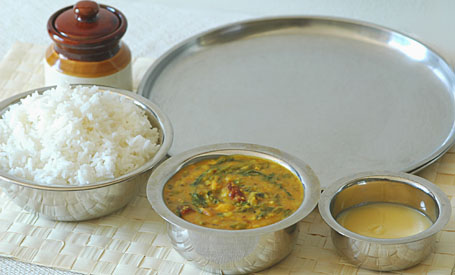
Vegetarian (shaakahaari) food is a mainstay of Andhra food. There are many such households in AP/TS (including mine!). Due to popularity of Woodlands and other such restaurants, most of it has been grouped under generic “South Indian” cuisine. So here we have tried to show the standards, some of them “south indian” yes, but also many pakka andhra vantalu as well.
Andhra Kooras (Curries) have the distinction of variety that includes not just banana fruit, but even banana stem and banana flowers. Different from Arati pandu (banana) is the standard plaintain (Aratikaaya).
Arati Doota Koora. Banana Stem. This is a rare dish, not commonly known among urbanites, but popular in traditional villages. It is also found in Vepadu (fry) form.
Arati Puvvu Koora. Banana Flower curry. This is a natural extension of the previous item. Very delicious. It can be argued that what Lotus stem and seed are to Kashmiri cuisine, so is Banana Stem and Flower to Andhra (especially its vegetarians).
Mamidi kaaya Pappu. Mango Daal. This is only natural for the state famous for Banganapalli mangoes. Other types of pappu that are typical and native include Gongura and Tomato.
Dosa kaaya Koora. Andhra Cucumber Curry.
Benda kaaya Gutti Koora. Stuffed Ladyfinger Curry. Gutti Vankaaya may be popular, but Gutti Bendakaaya gives memory!
Paalakoora Pulusu. Spinach Pulusu
Cabbage Koottu. Cabbage Stew. Though cabbage is not really a native Telugu word, and likely not a native vegetable, like the potato (bangaldumpa) it has been Telugufied.
Gongura Pulusu. Roselle Leaf Tamarind Stew
Gongura Pappu. Lentil with Roselle Leaf
Pacchi Vankaaya Koora. Roast Eggplant Stew
Bangaldumpa Podi. Sauteed, powdered, crispy potatoes,
Ulava Koottu. Pureed horse gram strew.
Non-Vegetarian

Telugu States are in fact very carnivorous states (technically, omnivorous!). Despite pure-veg types like me, non-veg is very popular among Telugus, who are no slouches in this department. Here are some of the many dishes:
Thotikoora Petakaayya. Spinach with dried Prawns.
Royyalu Pulusu. Tamarind sauce Prawns
Royyalu Meegada Koora. Prawn Malai Curry. Onions salt, sugar, tomatoes, and grated coconuts, along with turmeric & coriander.
Veinchana Royyalu. Curried Prawns with green chillies. An Indian Michelin starred chef featured it at a food festival, here.
Iguru Peethalu (Curried crab) uses tamarind
Podi Chaapa. Fried fish that uses two limes
Erra Chaapa: Red fish, i.e. fried fish in tomato gravy
Kobbari Maamsam. Mutton in Coconut sauce, use coconut cream
Chintha kaaya Maamsam. Mutton with tamarind leaves and flowers
Podi Maamsam. Spice fried mutton of Telangana.
Gongura Maamsam. Roselle Leaf Mutton.
Kodi Uragaaya. Chicken Pickle (also an excellent appetiser)
Kobbari Kodi. (Chicken served in coconut sauce). Also has poppy seeds, cinnamon, and coriander. Garnish with cashews or mint leaves.
Kodi Gaasi. Savoury chicken with curry leaves, peppercorns and coconut.
Tomato Kodi. (Tomato Chicken). This is a bit of a new addition as food historians believe Tomato is not native to India. Either way, tomato has been a key addition to Andhra food in recent years. In short, Tomato too has been “Telugufied!”.
Kodi Guddu Koora. Egg Curry. Naturally has green chillies and cream
Guddu Poratu. Egg Fry with Onions.
Guddu Pulusu. Boiled Egg in Tamarind Sauce.
Soups (Soopalu)
May sound weird, but Soopa is actually the Sanskrit word for Soup/Pulse. Pulusu is more of a tamarind stew and not generic soup. Stew itself is koottu. Anyway, these dishes may seem to be a surprising choice for “soups”, but the famous mulligatawny is nothing but our own rasam! So it is easy to group these dishes (normally poured over rice) under soups to have as you please.
Rasam (also known as Chaaru) has been raised to a high Art in AP. Rakka rakkaalu rasaalu really do come in many types. There is the standard chinthapandu rasam (tamarind), as well as nimakaayya rasam (lemon), and of course, Nripathi’s favourite, tomato rasam.
Pappu Chaaru. A popular version of the above, this features staple lentils of Andhra in a savoury soup.
Sambar
Though I personally prefer pappu chaaru (pappu saaru!! 🙂 ), sambar is a standard all you can have soup dish to be poured over rice or idli. It is called kvathitham in sanskrit, and is ancient in origin. Some recent authors state it originates in Maharashtra, though Southern Cuisine has come to embody it.
Desserts/Sweets (Madhurabhakshyalu)
.jpg)
Thokkudu Laddoo. Synonymous with deliciousness, these sweet gram flour balls with syrup. Great for an after dinner treat.
Sajjipaalu. Poori with rava filling (sweet)
Ariselu. Famous sweetened pancake of AP.
Bobbatlu. Jaggery with senaga pappu (chenna dhaal) and coconut
Kakinada Kaaja. Fried dough wafers dipped in sugary syrup (panchadhaara paakam)
Kova Kajjikaayi. Coconut and jaggery inside, outside is kova (condensed milk)

Paala Kova. Kova with milk
Pootharekalu. What would Andhra food be without its popular “Paper Sweet”!
Beverages (Paaneeyamulu)
Think before you consume! pic.twitter.com/19bfMohu4d
— Himalaya2Home (@Himalaya2Home) August 15, 2018
In what is probably one of the hottest (and humidest!) climates in India, it is only natural that we Andhraites have a long list of delicious drinks. Most of these cool the stomach, but early morning we all need a nice hot beverage too. So, I have divided them into hot & cold. One thing to be mindful of though is that traditional drinks of India are naturally sweetened (either with jaggery, honey, or cane sugar, not visham variety refined sugar).
Hot
Raagi jaava. Millet hot drink
Allam Chaayam. Ginger Tea
Filter Coffee. Individual regions (and castes!) may try to claim philter kaaphi as their own, but it is an all-South India staple.
![]()
Cold
Theeya Mamidi Rasam. Sweet mango juice. Not limited to Andhra, but popular.
Theeya Nimma Rasam. Sweet lemon juice. Not limited to Andhra, but popular.
Jaama Pandu Rasam. Guava juice. Probably the tastiest drink after mango, Zaampandu is very popular.
Kobbari Neelu. Coconut Water
Allam Majjiga. Chilled buttermilk with ginger.
Last but not least is a little tour of the triple regions of the Telugu land. We have seen above what mostly unites us. Here are some things that make each part of Telugu Thalli special. See for yourself!
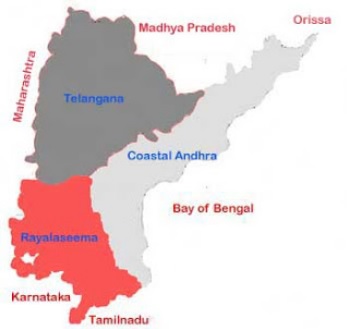
Telangana
Traditional Telangana fare is known for its use of Bengal gram and millet. Gongura here is known as puntikoora and is also used plentifully. Some readers may note that it has received most outside influence (from Maharashtra and elsewhere), and that is true, but we will naturally focus on the fundamentally Telugu aspects of Telangana.
Often mistaken for Hyderabadi Nizami, Cuisine of Telangana is separate & very distinct. True to the land of Saayudha Poratam, it is the food of the people! TS loves its nonveg, but a variety of dishes can be found. Some might be unique, while others may simply be a unique take. Due to foreign nizami colonists, many of the traditional district names have been changed & originals have been marginalised (i.e. Palamooru, Manukota, Bhuvanagiri). Therefore, rather than give by district, will just give a general overview. [Readers can give district specialties in the comments though].
Sarvapindi. Rice flour crispy chips.
Sakinalu. Rice flour dough circles fried in oil. A cross between vadialu and muruku!
Beerakaaya Koora. Ribbed gourd with Bengal gram. Common, but a Telangana specialty
Telangana Maamsa koora. Telangana Style mutton curry.
Dampudu Maamsam. (Telangana Specialty). Sauteed lamb & liver
Gudlu Geniga Pappu (Egg curry with Bengal Gram. Telangana). Made with Tomatoes
Rayalaseema
Rayalaseema ruchulu have become a brand that even top chefs are now taking note of! Rayalaseema recipes are most famous for the use of Raagi (Finger Millet). This is an under-used but super-healthy ingredient that can be used for all meals and all occasions. Some like Raagi dosa, but my personal favourite is to have raagi as cream of wheat breakfast in the morning (with raisins and nuts). It can also be served as a hot beverage (but be careful with the temperature! It can be cold on outside but super-hot on the inside!).
Ulavachaaru (horse-gram) is shared with Telangana as a regional favourite sauce. If Telangana has some influence from Maharashtra, then Rayalaseema has some influence from Karnataka. In fact, a part of it was called Karu Nadu in Kakatiya times!.
Anantapur—Payneelu. This sugared rice flour sweet is a specialty of the region.
Kadapa—Ragi Sankati with Chicken Curry.
Kurnool— Raskora Undalu. Coconut laddoo
Tirupati—Pulihora, Bhoondi Laddoo here is practically patented (i.e. Geographic Indicator)
Kosta
Last (but certainly not least!), is Kosta (Coastal Andhra). True to the name, Coastal Andhra is seafood central, with variety of prawns (royyalu), fish (chaapalu), and crab (iguru) recipes that make the mouths of even vegetarians water…just kidding ;P . Before our brothers and sisters from Vizag ask “what about Uttarandhra?“, it will be discussed here, with any specialties being mentioned as well. [You can also give your own native sub-region submissions in the comments below].
Nellore—Chaapala Pulusu (specialty)
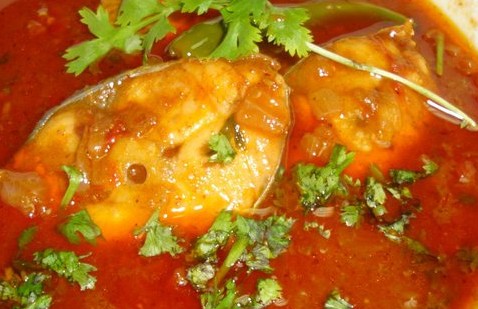
Kakinada—Royyalu koora. And, of course, Kakinada Kaaja.
Guntur—Mirapa kaaya. Kaaram (Kaaram Pacchidi)
Vijayawada—Gongura Maamsam. Gongura in everything, means Gongura in mutton!
Machilipatnam—Bandhar Laddoo, Chaapala Vepadu
Raajamahendri (Rajahmundry/Rajamahendravaram)—Mamidi Thaandra
Vizag—Royyalu Vepadu, Goru-meeteelu (they make kova with a flip of the finger)
Vizianagaram—Raju Gaari Pulao. Raaju gaaru’s Royal Chicken Pulao
Conclusion
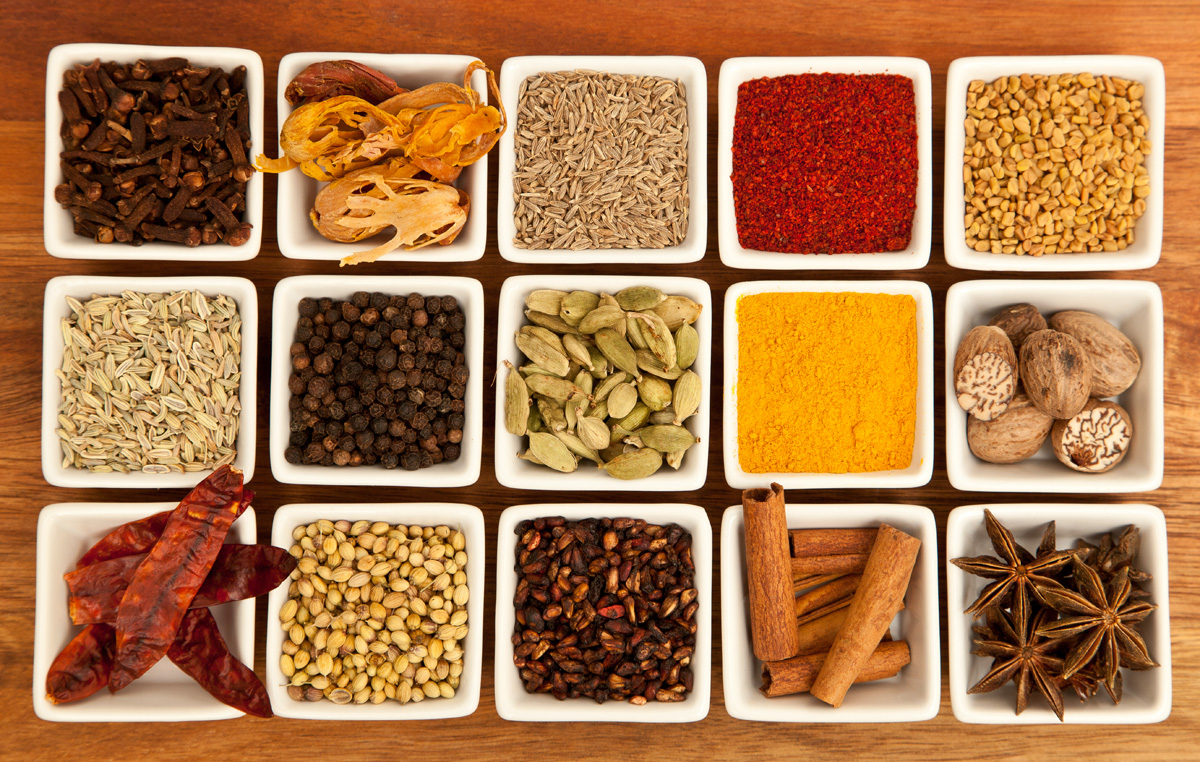
Well, there it is! After 3 years in the making, the first installment of Andhra Aahaara Yatra is complete. One of the many takeaways is that time has come for Andhraites to promote our own Cuisine. Hyderabadi cuisine (i.e. Biryani) is its own brand, and Andhra cuisine from Pulao to Pacchadi to Pootharekkalu is its own thing. If we don’t promote it and take pride in our food, who will? It is fine to enjoy different types of food, but attitude should be nothing beats mana inti vantalu. From veg TS Beerakaaya to nonveg Nellore Chaapala Pulusu to Vizianagaram Raju Gaari Pulao, there is so much to enjoy. Also rather than just this “mess” or that “mess”, time to also give upscale Andhra recipes & restaurants.
How to get all the recipes?—Write a book!! It took much time and research to put together an article on Andhra Aahaaram. With this list, our own Telugu people can now put together detailed Recipes books on different types of Telugu food (and get it translated into different languages!). This is a step in that direction, and time has come to promote Andhra Cuisine, and even if you come from Telangana, celebrate our united Telugu food.
Most importantly, we must also appreciate how much we have in common with the Ancient Indian Food heritage shared by all Indians.
Anyway, hope you enjoyed it, and stay tuned for part 2!! In the mean time, take a look at the offerings at the Andhra Food Fest, and if you are in Guntur, get all you can eat!!
References:
- Karuna. Delicious Recipes from Andhra. Jaico Publishing House: Delhi. 2013
- Latif, Bilkees. The Essential Andhra Cookbook. Penguin Books: Gurgaon. 2014
- Yaddhanapudi, Sulochanarani. Vegetarian Vantalu Pustakam. Emesco Books: Vijayawada. 2005
- Maithili, Venkatesvara Rao. Pedda Vantala Pustakam. Gollapudi. Accessed, 2017.

